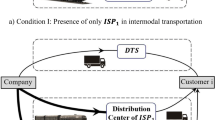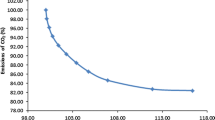Abstract
An implementation of the International Freight Simultaneous Transportation Equilibrium Model (IFSTEM) that developed in United Nations Economic and Social Commission for Western Asia (ESCWA), to the goods trade through the ports and lands of Jordon, Syria, and Lebanon is presented. Although some socio-economic variables, which are not available, were required for IFSTEM model calibration, some reasonable assumptions were made and it was good enough to draw the following main findings: the IFSTEM model was able to replicate the observed path and O-D pair goods flows for year 2001 through its initial solution; the IFSTEM final solution suggested that the path distribution for most observed O-D pairs flows is not optimal due to the exporters depend only one some measure of attractiveness in their path choice and it should be redistributed to have a great saving in the total freight cost; the IFSTEM can be consider as a good decision support tool that is able to evaluate the value of any scenario that can be reflected through any change in the costs and/or times of its link cost function or any change in the socio-economic variables, as the case of year 2007 prediction.
Similar content being viewed by others
References
Boyce, D. (2007a). Forecasting travel on congested urban transportation networks: review and prospects for network equilibrium models. Networks and Spatial Economics, 7, 99–128.
Boyce, D. (2007b). Future research on urban transportation network modeling. Regional Science and Urban Economics, 37, 472–481.
Boyce, D., & Xiong, C. (2007). Forecasting travel for very large cities: challenges and opportunities for China. Transportmetrica, 3, 1–19.
ESCWA (United Nations Economic and Social Commission for Western Asia) (1999). Survey of economic and social developments in the ESCWA region 1996–1997 (Report Number E/ESCWA/ED/1999/5).
ESCWA (United Nations Economic and Social Commission for Western Asia) (2000a). Methodological framework of the integrated transport system in the Arab Mashreq (Vol. I): general outline and main features (E/ESCWA/TRANS/2000/2).
ESCWA (United Nations Economic and Social Commission for Western Asia) (2000b). Methodological framework for the integrated transport system in the Arab Mashreq (Vol. II): a policy-sensitive model for predicting international freight flows (trade) (E/ESCWA/TRANS/2000/2/Add.1).
ESCWA (United Nations Economic and Social Commission for Western Asia) (2003a). An economic feasibility study to facilitate goods trade through the ports and lands of Jordon, Syria, and Lebanon (E/ESCWA/GRID/2003/33).
ESCWA (United Nations Economic and Social Commission for Western Asia) (2003b). Information system for the integrated transport system in the Arab Mashreq: information of the existing situation for good trade through the ports and lands of Jordon, Syria, and Lebanon (E/ESCWA/GRID/2003/34).
ESCWA (United Nations Economic and Social Commission for Western Asia) (2003c). Methodological framework for the integrated transport system in the Arab Mashreq (Vol. III): methodology for future prediction and economic evaluation of different scenarios of goods trade facilitation through the ports and lands of Jordon, Syria, and Lebanon (E/ESCWA/GRID/2003/35).
Farahat, A. M. (1999). Preliminary thoughts on ITSAM information system (ITSAM-IS). Paper presented at the expert group meeting on the harmonization of transport norms and legislative instruments for regional cooperation in the ESCWA region, including UN/EDIFACT, held in Beirut from 16 to 18 November 1999 (E/ESCWA/TRANS/1999/WG. 2/10).
Friesz, T. L., & Harker, P. T. (1985). Freight network equilibrium: a review of the state of the art. In A. F. Daughety (Ed.), Analytical studies in transport economics. Cambridge: MIT Press.
Ham, H., Kim, T. J., & Boyce, D. (2005). Implementation and estimation of a combined model of interregional, multimodal commodity shipments and transportation network flows. Transportation Research 39B, 65–79.
Hasan, M. K. (1991) Comparative analysis of alternative simultaneous transportation network equilibrium models. Doctoral dissertation, Texas A&M University, Texas, USA.
Hasan, M. K., & AlGadhi, S. A. (1998). Application of simultaneous and sequential transportation network equilibrium models to Riyadh, Saudi Arabia (Transportation Research Record 1645). TRB, National Research Council, Washington, D.C. (pp. 127–132).
Hasan, M. K., & Safwat, K. N. A. (2000). Comparison of two transportation network equilibrium modeling approaches. Journal of Transportation Engineering, 126(1), 35–40.
Hasan, M. K., & Dashti, H. M. (2007). A multiclass simultaneous transportation equilibrium model. Networks and spatial economics (Vol. 7(3), pp. 197–211). New York: Springer.
Safwat, K. N. A. (1987a) Application of simultaneous transportation equilibrium model to intercity passenger travel in Egypt (Transportation Research Record 1120). TRB, National Research Council, Washington, D.C. (pp. 52–59).
Safwat, K. N. A. (1987b). Computational experience with application of simultaneous transportation equilibrium model to intercity passenger travel in Egypt (Transportation Research Record 1120). TRB, National Research Council, Washington, D.C. (pp. 60–67).
Safwat, K. N. A., & Walton, C. M. (1988). Computational experience with and application of a simultaneous transportation equilibrium model to urban travel in Austin, Texas: Computational results. Transportation Research B, 22B(6), 457–467.
Safwat, K. N. A., & Magnanti, T. L. (1988). A combined trip generation, trip distribution, modal split and traffic assignment model. Transportation Science, 22(1), 14–30.
Safwat, K. N. A., & Hasan, M. K. (1989). Computational experience with simultaneous transportation equilibrium model under varying parameters (Transportation Research Record 1251). TRB, National Research Council, Washington, D.C. (pp. 17–23).
Safwat, K. N. A., & Hasan, M. K. (2004). Predicting international freight flows for trade: simultaneous multimodal, multicommodity, network equilibrium model (Transportation Research Record 1882) (pp. 129–139).
Siegel, J. D., Cea, J., Fernández, J. E., Rodríquez, E. E., & Boyce, D. (2006). Comparisons of urban travel forecasts prepared with the sequential procedure and a combined model. Networks and Spatial Economics, 6, 135–148.
Author information
Authors and Affiliations
Corresponding author
Rights and permissions
About this article
Cite this article
Hasan, M.K. Multimodal, multicommodity international freight simultaneous transportation network equilibrium model. Telecommun Syst 40, 39–54 (2009). https://doi.org/10.1007/s11235-008-9129-6
Published:
Issue Date:
DOI: https://doi.org/10.1007/s11235-008-9129-6




